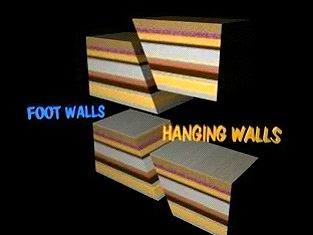As we have already see , if we have three seismic stations recording the event then it is possible to locate the epicenter and focus (depth) by using triangulation. The P wave may also give us the direction of the fault movement.
If the seismic station is located in the direction of movement, then the first wave to reach the station will be a compression wave, and a center located behind the movement will see an expansion wave.

Fault line is the WHITE LINE through the middle of the diagram from left to right. The fault movement directions are indicated by the yellow arrows
<= = = = and = = = =>.
The diagonal arrows represent the directions of both compression wave and expansion waves. The arrows that move away from the center are compression waves. They move in the same direction as fault movement.
The arrow that point to the center represent expansion waves and move away from the fault movement.
Any seismic centers (seismometers) that are in the compressive direction will see compression waves first. Any that lie in the other direction will see expansion wave. This aids in the determination of the fault movement at the time the quake begins.
1.) Divergent Plates (tensional)
2.) Convergent plates (compressional)
3.) Transform plates (shear stress)
Each plate margin is a focal point for earthquakes and each is unique.
There are two types of convergent sites.
A.) where oceanic crust/lithosphere slides beneath another plate and form a subduction zone.
This is a complex area, and as the lithosphere first bends into subduction, it causes normal faulting near the surface of the plate. These earthquakes are shallow, normal faulted, and usually of low Richter size.
As the plate plunges deeper beneath the second plate, the boundary becomes a thrust fault, and Richter magnitudes tend to high, faulting is of the thrust variety, and they are often focused at 100 km or deeper. The quakes are centered in the subducting slab.
At more depth there appears to be a tension type of faulting which support the concept that the lithosphere is sinking under its own weight.
B.) zones where two continents collide.
Where the crust is thickened, and earthquakes my happen at even lower depth (300 km), and have high Richter magnitude and are of the thrust fault type due to very high compressive forces.

Normal fault: hanging wall drops (down direction)
Reverse fault: hanging wall rises (up direction)
Strike fault: walls move like transverse plates
Oblique fault: like the movie - two directions. (Strike/Slip)
1.) animal behavior - animals seem to be able to foretell an earthquake. Their behavior changes, often radically.
2.) small physical changes in the rock: small cracks, drops in well water, uplift, tilting of the ground.
3.) past history and a recording of the time scales. Around the Pacific rim there are numerous spots where there are currently an absence of earthquakes for longer than normal time frames. The earth continues to build up stored energy and eventually will let go. These areas are watched more frequently.
Currently two areas are of interest ...
1). The border between Equador and Peru
2.) Southern California
| NEXT | TOC | PREV |